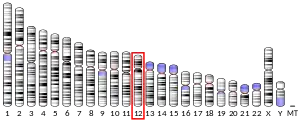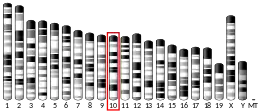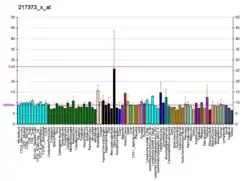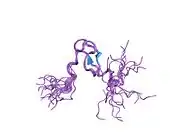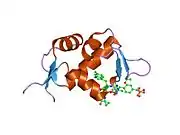Mouse double minute 2 homolog (MDM2) also known as E3 ubiquitin-protein ligase Mdm2 is a protein that in humans is encoded by the MDM2 gene.[5][6] Mdm2 is an important negative regulator of the p53 tumor suppressor. Mdm2 protein functions both as an E3 ubiquitin ligase that recognizes the N-terminal trans-activation domain (TAD) of the p53 tumor suppressor and as an inhibitor of p53 transcriptional activation.
Discovery and expression in tumor cells
The murine double minute (mdm2) oncogene, which codes for the Mdm2 protein, was originally cloned, along with two other genes (mdm1 and mdm3) from the transformed mouse cell line 3T3-DM. Mdm2 overexpression, in cooperation with oncogenic Ras, promotes transformation of primary rodent fibroblasts, and mdm2 expression led to tumor formation in nude mice. The human homologue of this protein was later identified and is sometimes called Hdm2. Further supporting the role of mdm2 as an oncogene, several human tumor types have been shown to have increased levels of Mdm2, including soft tissue sarcomas and osteosarcomas as well as breast tumors. The MDM2 oncoprotein ubiquitinates and antagonizes p53 but may also carry out p53-independent functions. MDM2 supports the Polycomb-mediated repression of lineage-specific genes, independent of p53. MDM2 depletion in the absence of p53 promoted the differentiation of human mesenchymal stem cells and diminished clonogenic survival of cancer cells. Most of the MDM2-controlled genes also responded to the inactivation of the Polycomb Repressor Complex 2 (PRC2) and its catalytic component EZH2. MDM2 physically associated with EZH2 on chromatin, enhancing the trimethylation of histone 3 at lysine 27 (H3K27me3) and the ubiquitination of histone 2A at lysine 119 (H2AK119) at its target genes. Removing MDM2 simultaneously with the H2AK119 E3 ligase Ring1B/RNF2 further induced these genes and synthetically arrested cell proliferation.[7]
An additional Mdm2 family member, Mdm4 (also called MdmX), has been discovered and is also an important negative regulator of p53.
MDM2 is also required for organ development and tissue homeostasis because unopposed p53 activation leads to p53-overactivation-dependent cell death, referred to as podoptosis. Podoptosis is caspase-independent and, therefore, different from apoptosis. The mitogenic role of MDM2 is also needed for wound healing upon tissue injury, while MDM2 inhibition impairs re-epithelialization upon epithelial damage. In addition, MDM2 has p53-independent transcription factor-like effects in nuclear factor-kappa beta (NFκB) activation. Therefore, MDM2 promotes tissue inflammation and MDM2 inhibition has potent anti-inflammatory effects in tissue injury. So, MDM2 blockade had mostly anti-inflammatory and anti-mitotic effects that can be of additive therapeutic efficacy in inflammatory and hyperproliferative disorders such as certain cancers or lymphoproliferative autoimmunity, such as systemic lupus erythematosus or crescentic glomerulonephritis.[8]
Ubiquitination target: p53
The key target of Mdm2 is the p53 tumor suppressor. Mdm2 has been identified as a p53 interacting protein that represses p53 transcriptional activity. Mdm2 achieves this repression by binding to and blocking the N-terminal trans-activation domain of p53. Mdm2 is a p53 responsive gene—that is, its transcription can be activated by p53. Thus when p53 is stabilized, the transcription of Mdm2 is also induced, resulting in higher Mdm2 protein levels.
E3 ligase activity
The E3 ubiquitin ligase MDM2 is a negative regulator of the p53 tumor suppressor protein. MDM2 binds and ubiquitinates p53, facilitating it for degradation. p53 can induce transcription of MDM2, generating a negative feedback loop.[9] Mdm2 also acts as an E3 ubiquitin ligase, targeting both itself and p53 for degradation by the proteasome (see also ubiquitin). Several lysine residues in p53 C-terminus have been identified as the sites of ubiquitination, and it has been shown that p53 protein levels are downregulated by Mdm2 in a proteasome-dependent manner. Mdm2 is capable of auto-polyubiquitination, and in complex with p300, a cooperating E3 ubiquitin ligase, is capable of polyubiquitinating p53. In this manner, Mdm2 and p53 are the members of a negative feedback control loop that keeps the level of p53 low in the absence of p53-stabilizing signals. This loop can be interfered with by kinases and genes like p14arf when p53 activation signals, including DNA damage, are high.
Structure and function
The full-length transcript of the mdm2 gene encodes a protein of 491 amino acids with a predicted molecular weight of 56kDa. This protein contains several conserved structural domains including an N-terminal p53 interaction domain, the structure of which has been solved using x-ray crystallography. The Mdm2 protein also contains a central acidic domain (residues 230–300). The phosphorylation of residues within this domain appears to be important for regulation of Mdm2 function. In addition, this region contains nuclear export and import signals that are essential for proper nuclear-cytoplasmic trafficking of Mdm2. Another conserved domain within the Mdm2 protein is a zinc finger domain, the function of which is poorly understood.
Mdm2 also contains a C-terminal RING domain (amino acid residues 430–480), which contains a Cis3-His2-Cis3 consensus that coordinates two ions of zinc. These residues are required for zinc binding, which is essential for proper folding of the RING domain. The RING domain of Mdm2 confers E3 ubiquitin ligase activity and is sufficient for E3 ligase activity in Mdm2 RING autoubiquitination. The RING domain of Mdm2 is unique in that it incorporates a conserved Walker A or P-loop motif characteristic of nucleotide binding proteins, as well as a nucleolar localization sequence. The RING domain also binds specifically to RNA, although the function of this is poorly understood.
Regulation
There are several known mechanisms for regulation of Mdm2. One of these mechanisms is phosphorylation of the Mdm2 protein. Mdm2 is phosphorylated at multiple sites in cells. Following DNA damage, phosphorylation of Mdm2 leads to changes in protein function and stabilization of p53. Additionally, phosphorylation at certain residues within the central acidic domain of Mdm2 may stimulate its ability to target p53 for degradation. HIPK2 is a protein that regulates Mdm2 in this way. The induction of the p14arf protein, the alternate reading frame product of the p16INK4a locus, is also a mechanism of negatively regulating the p53-Mdm2 interaction. p14arf directly interacts with Mdm2 and leads to up-regulation of p53 transcriptional response. ARF sequesters Mdm2 in the nucleolus, resulting in inhibition of nuclear export and activation of p53, since nuclear export is essential for proper p53 degradation.
Inhibitors of the MDM2-p53 interaction include the cis-imidazoline analog nutlin.[10]
Levels and stability of Mdm2 are also modulated by ubiquitylation. Mdm2 auto ubiquitylates itself, which allows for its degradation by the proteasome. Mdm2 also interacts with a ubiquitin specific protease, USP7, which can reverse Mdm2-ubiquitylation and prevent it from being degraded by the proteasome. USP7 also protects from degradation the p53 protein, which is a major target of Mdm2. Thus Mdm2 and USP7 form an intricate circuit to finely regulate the stability and activity of p53, whose levels are critical for its function.
Interactions
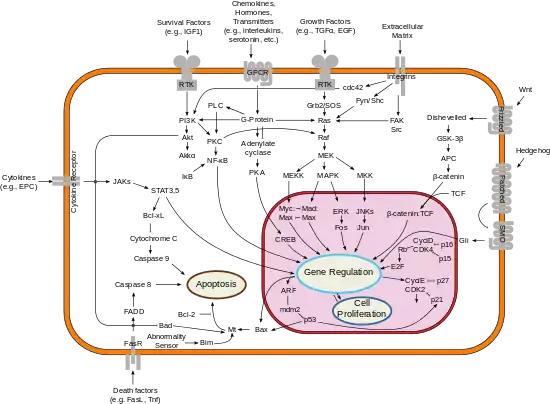
Mdm2 has been shown to interact with:
- ABL1,[11]
- ARRB1,[12][13]
- ARRB2,[12][13][14]
- CCNG1,[15]
- CTBP1,[16]
- CTBP2,[16]
- DAXX,[17]
- DHFR,[18]
- EP300,[19]
- ERICH3,[20]
- FKBP3,[21]
- FOXO4,[22]
- GNL3,[23]
- HDAC1,[24]
- HIF1A,[25][26]
- HTATIP,[27]
- IGF1R,[28]
- MDM4,[29][30][31][32]
- NUMB,[33][34]
- P16,[17][35][36][37][38]
- P53,[39][40]
- P73,[41][42]
- PCAF,[43]
- PSMD10,[44]
- PSME3,[45]
- RPL5,[23][35][46]
- RPL11,[23][35]
- PML,[47][48][49][50]
- RPL26,[51]
- RRM2B,[52]
- RYBP,[53]
- TBP,[54][55] and
- UBC.[17][56][57]
Mdm2 p53-independent role
Mdm2 overexpression was shown to inhibit DNA double-strand break repair mediated through a novel, direct interaction between Mdm2 and Nbs1 and independent of p53. Regardless of p53 status, increased levels of Mdm2, but not Mdm2 lacking its Nbs1-binding domain, caused delays in DNA break repair, chromosomal abnormalities, and genome instability. These data demonstrated Mdm2-induced genome instability can be mediated through Mdm2:Nbs1 interactions and independent from its association with p53.
References
- 1 2 3 GRCh38: Ensembl release 89: ENSG00000135679 - Ensembl, May 2017
- 1 2 3 GRCm38: Ensembl release 89: ENSMUSG00000020184 - Ensembl, May 2017
- ↑ "Human PubMed Reference:". National Center for Biotechnology Information, U.S. National Library of Medicine.
- ↑ "Mouse PubMed Reference:". National Center for Biotechnology Information, U.S. National Library of Medicine.
- ↑ Oliner JD, Kinzler KW, Meltzer PS, George DL, Vogelstein B (July 1992). "Amplification of a gene encoding a p53-associated protein in human sarcomas". Nature. 358 (6381): 80–3. Bibcode:1992Natur.358...80O. doi:10.1038/358080a0. hdl:2027.42/62637. PMID 1614537. S2CID 1056405.
- ↑ Wade M, Wong ET, Tang M, Stommel JM, Wahl GM (November 2006). "Hdmx modulates the outcome of p53 activation in human tumor cells". The Journal of Biological Chemistry. 281 (44): 33036–44. doi:10.1074/jbc.M605405200. PMID 16905769. S2CID 16619596.
- ↑ Wienken M, Dickmanns A, Nemajerova A, Kramer D, Najafova Z, Weiss M, Karpiuk O, Kassem M, Zhang Y, Lozano G, Johnsen SA, Moll UM, Zhang X, Dobbelstein M (January 2016). "MDM2 Associates with Polycomb Repressor Complex 2 and Enhances Stemness-Promoting Chromatin Modifications Independent of p53". Molecular Cell. 61 (1): 68–83. doi:10.1016/j.molcel.2015.12.008. PMC 6284523. PMID 26748827.
- ↑ Ebrahim M, Mulay SR, Anders HJ, Thomasova D (November 2015). "MDM2 beyond cancer: podoptosis, development, inflammation, and tissue regeneration". Histology and Histopathology. 30 (11): 1271–82. doi:10.14670/HH-11-636. PMID 26062755.
- ↑ Huun J, Gansmo LB, Mannsåker B, Iversen GT, Sommerfelt-Pettersen J, Øvrebø JI, Lønning PE, Knappskog S (October 2017). "The Functional Roles of the MDM2 Splice Variants P2-MDM2-10 and MDM2-∆5 in Breast Cancer Cells". Translational Oncology. 10 (5): 806–817. doi:10.1016/j.tranon.2017.07.006. PMC 5576977. PMID 28844019.
- ↑ Vassilev LT, Vu BT, Graves B, Carvajal D, Podlaski F, Filipovic Z, Kong N, Kammlott U, Lukacs C, Klein C, Fotouhi N, Liu EA (February 2004). "In vivo activation of the p53 pathway by small-molecule antagonists of MDM2". Science. 303 (5659): 844–8. Bibcode:2004Sci...303..844V. doi:10.1126/science.1092472. PMID 14704432. S2CID 16132757.
- ↑ Goldberg Z, Vogt Sionov R, Berger M, Zwang Y, Perets R, Van Etten RA, Oren M, Taya Y, Haupt Y (July 2002). "Tyrosine phosphorylation of Mdm2 by c-Abl: implications for p53 regulation". The EMBO Journal. 21 (14): 3715–27. doi:10.1093/emboj/cdf384. PMC 125401. PMID 12110584.
- 1 2 Wang P, Wu Y, Ge X, Ma L, Pei G (March 2003). "Subcellular localization of beta-arrestins is determined by their intact N domain and the nuclear export signal at the C terminus". The Journal of Biological Chemistry. 278 (13): 11648–53. doi:10.1074/jbc.M208109200. PMID 12538596. S2CID 8453277.
- 1 2 Shenoy SK, Xiao K, Venkataramanan V, Snyder PM, Freedman NJ, Weissman AM (August 2008). "Nedd4 mediates agonist-dependent ubiquitination, lysosomal targeting, and degradation of the beta2-adrenergic receptor". The Journal of Biological Chemistry. 283 (32): 22166–76. doi:10.1074/jbc.M709668200. PMC 2494938. PMID 18544533.
- ↑ Wang P, Gao H, Ni Y, Wang B, Wu Y, Ji L, Qin L, Ma L, Pei G (February 2003). "Beta-arrestin 2 functions as a G-protein-coupled receptor-activated regulator of oncoprotein Mdm2". The Journal of Biological Chemistry. 278 (8): 6363–70. doi:10.1074/jbc.M210350200. PMID 12488444. S2CID 28251970.
- ↑ Zhao L, Samuels T, Winckler S, Korgaonkar C, Tompkins V, Horne MC, Quelle DE (January 2003). "Cyclin G1 has growth inhibitory activity linked to the ARF-Mdm2-p53 and pRb tumor suppressor pathways". Molecular Cancer Research. 1 (3): 195–206. PMID 12556559.
- 1 2 Mirnezami AH, Campbell SJ, Darley M, Primrose JN, Johnson PW, Blaydes JP (July 2003). "Hdm2 recruits a hypoxia-sensitive corepressor to negatively regulate p53-dependent transcription" (PDF). Current Biology. 13 (14): 1234–9. doi:10.1016/S0960-9822(03)00454-8. PMID 12867035. S2CID 2451241.
- 1 2 3 Ivanchuk SM, Mondal S, Rutka JT (June 2008). "p14ARF interacts with DAXX: effects on HDM2 and p53". Cell Cycle. 7 (12): 1836–50. doi:10.4161/cc.7.12.6025. PMID 18583933. S2CID 13168647.
- ↑ Maguire M, Nield PC, Devling T, Jenkins RE, Park BK, Polański R, Vlatković N, Boyd MT (May 2008). "MDM2 regulates dihydrofolate reductase activity through monoubiquitination". Cancer Research. 68 (9): 3232–42. doi:10.1158/0008-5472.CAN-07-5271. PMC 3536468. PMID 18451149.
- ↑ Grossman SR, Perez M, Kung AL, Joseph M, Mansur C, Xiao ZX, Kumar S, Howley PM, Livingston DM (October 1998). "p300/MDM2 complexes participate in MDM2-mediated p53 degradation". Molecular Cell. 2 (4): 405–15. doi:10.1016/S1097-2765(00)80140-9. PMID 9809062.
- ↑ Miyamoto-Sato E, Fujimori S, Ishizaka M, Hirai N, Masuoka K, Saito R, Ozawa Y, Hino K, Washio T, Tomita M, Yamashita T, Oshikubo T, Akasaka H, Sugiyama J, Matsumoto Y, Yanagawa H (Feb 2010). "A comprehensive resource of interacting protein regions for refining human transcription factor networks". PLOS ONE. 5 (2): e9289. Bibcode:2010PLoSO...5.9289M. doi:10.1371/journal.pone.0009289. PMC 2827538. PMID 20195357.
- ↑ Ochocka AM, Kampanis P, Nicol S, Allende-Vega N, Cox M, Marcar L, Milne D, Fuller-Pace F, Meek D (February 2009). "FKBP25, a novel regulator of the p53 pathway, induces the degradation of MDM2 and activation of p53". FEBS Letters. 583 (4): 621–6. doi:10.1016/j.febslet.2009.01.009. PMID 19166840. S2CID 6110.
- ↑ Brenkman AB, de Keizer PL, van den Broek NJ, Jochemsen AG, Burgering BM (2008). "Mdm2 induces mono-ubiquitination of FOXO4". PLOS ONE. 3 (7): e2819. Bibcode:2008PLoSO...3.2819B. doi:10.1371/journal.pone.0002819. PMC 2475507. PMID 18665269.
- 1 2 3 Dai MS, Sun XX, Lu H (July 2008). "Aberrant expression of nucleostemin activates p53 and induces cell cycle arrest via inhibition of MDM2". Molecular and Cellular Biology. 28 (13): 4365–76. doi:10.1128/MCB.01662-07. PMC 2447154. PMID 18426907.
- ↑ Ito A, Kawaguchi Y, Lai CH, Kovacs JJ, Higashimoto Y, Appella E, Yao TP (November 2002). "MDM2-HDAC1-mediated deacetylation of p53 is required for its degradation". The EMBO Journal. 21 (22): 6236–45. doi:10.1093/emboj/cdf616. PMC 137207. PMID 12426395.
- ↑ Chen D, Li M, Luo J, Gu W (April 2003). "Direct interactions between HIF-1 alpha and Mdm2 modulate p53 function". The Journal of Biological Chemistry. 278 (16): 13595–8. doi:10.1074/jbc.C200694200. PMID 12606552. S2CID 85351036.
- ↑ Ravi R, Mookerjee B, Bhujwalla ZM, Sutter CH, Artemov D, Zeng Q, Dillehay LE, Madan A, Semenza GL, Bedi A (January 2000). "Regulation of tumor angiogenesis by p53-induced degradation of hypoxia-inducible factor 1alpha". Genes & Development. 14 (1): 34–44. doi:10.1101/gad.14.1.34. PMC 316350. PMID 10640274.
- ↑ Legube G, Linares LK, Lemercier C, Scheffner M, Khochbin S, Trouche D (April 2002). "Tip60 is targeted to proteasome-mediated degradation by Mdm2 and accumulates after UV irradiation". The EMBO Journal. 21 (7): 1704–12. doi:10.1093/emboj/21.7.1704. PMC 125958. PMID 11927554.
- ↑ Sehat B, Andersson S, Girnita L, Larsson O (July 2008). "Identification of c-Cbl as a new ligase for insulin-like growth factor-I receptor with distinct roles from Mdm2 in receptor ubiquitination and endocytosis". Cancer Research. 68 (14): 5669–77. doi:10.1158/0008-5472.CAN-07-6364. PMID 18632619.
- ↑ Kadakia M, Brown TL, McGorry MM, Berberich SJ (December 2002). "MdmX inhibits Smad transactivation". Oncogene. 21 (57): 8776–85. doi:10.1038/sj.onc.1205993. PMID 12483531. S2CID 38919290.
- ↑ Tanimura S, Ohtsuka S, Mitsui K, Shirouzu K, Yoshimura A, Ohtsubo M (March 1999). "MDM2 interacts with MDMX through their RING finger domains". FEBS Letters. 447 (1): 5–9. doi:10.1016/S0014-5793(99)00254-9. PMID 10218570. S2CID 20021952.
- ↑ Badciong JC, Haas AL (December 2002). "MdmX is a RING finger ubiquitin ligase capable of synergistically enhancing Mdm2 ubiquitination". The Journal of Biological Chemistry. 277 (51): 49668–75. doi:10.1074/jbc.M208593200. PMID 12393902. S2CID 21036861.
- ↑ Linke K, Mace PD, Smith CA, Vaux DL, Silke J, Day CL (May 2008). "Structure of the MDM2/MDMX RING domain heterodimer reveals dimerization is required for their ubiquitylation in trans". Cell Death and Differentiation. 15 (5): 841–8. doi:10.1038/sj.cdd.4402309. PMID 18219319. S2CID 24048476.
- ↑ Yogosawa S, Miyauchi Y, Honda R, Tanaka H, Yasuda H (March 2003). "Mammalian Numb is a target protein of Mdm2, ubiquitin ligase". Biochemical and Biophysical Research Communications. 302 (4): 869–72. doi:10.1016/S0006-291X(03)00282-1. PMID 12646252.
- ↑ Colaluca IN, Tosoni D, Nuciforo P, Senic-Matuglia F, Galimberti V, Viale G, Pece S, Di Fiore PP (January 2008). "NUMB controls p53 tumour suppressor activity". Nature. 451 (7174): 76–80. Bibcode:2008Natur.451...76C. doi:10.1038/nature06412. PMID 18172499. S2CID 4431258.
- 1 2 3 Zhang Y, Wolf GW, Bhat K, Jin A, Allio T, Burkhart WA, Xiong Y (December 2003). "Ribosomal protein L11 negatively regulates oncoprotein MDM2 and mediates a p53-dependent ribosomal-stress checkpoint pathway". Molecular and Cellular Biology. 23 (23): 8902–12. doi:10.1128/MCB.23.23.8902-8912.2003. PMC 262682. PMID 14612427.
- ↑ Zhang Y, Xiong Y, Yarbrough WG (March 1998). "ARF promotes MDM2 degradation and stabilizes p53: ARF-INK4a locus deletion impairs both the Rb and p53 tumor suppression pathways". Cell. 92 (6): 725–34. doi:10.1016/S0092-8674(00)81401-4. PMID 9529249. S2CID 334187.
- ↑ Clark PA, Llanos S, Peters G (July 2002). "Multiple interacting domains contribute to p14ARF mediated inhibition of MDM2". Oncogene. 21 (29): 4498–507. doi:10.1038/sj.onc.1205558. PMID 12085228. S2CID 5636220.
- ↑ Pomerantz J, Schreiber-Agus N, Liégeois NJ, Silverman A, Alland L, Chin L, Potes J, Chen K, Orlow I, Lee HW, Cordon-Cardo C, DePinho RA (March 1998). "The Ink4a tumor suppressor gene product, p19Arf, interacts with MDM2 and neutralizes MDM2's inhibition of p53". Cell. 92 (6): 713–23. doi:10.1016/S0092-8674(00)81400-2. PMID 9529248. S2CID 17190271.
- ↑ Haupt Y, Maya R, Kazaz A, Oren M (May 1997). "Mdm2 promotes the rapid degradation of p53". Nature. 387 (6630): 296–9. Bibcode:1997Natur.387..296H. doi:10.1038/387296a0. PMID 9153395. S2CID 4336620.
- ↑ Honda R, Tanaka H, Yasuda H (December 1997). "Oncoprotein MDM2 is a ubiquitin ligase E3 for tumor suppressor p53". FEBS Letters. 420 (1): 25–7. doi:10.1016/S0014-5793(97)01480-4. PMID 9450543. S2CID 29014813.
- ↑ Bálint E, Bates S, Vousden KH (July 1999). "Mdm2 binds p73 alpha without targeting degradation". Oncogene. 18 (27): 3923–9. doi:10.1038/sj.onc.1202781. PMID 10435614. S2CID 36277590.
- ↑ Zeng X, Chen L, Jost CA, Maya R, Keller D, Wang X, Kaelin WG, Oren M, Chen J, Lu H (May 1999). "MDM2 suppresses p73 function without promoting p73 degradation". Molecular and Cellular Biology. 19 (5): 3257–66. doi:10.1128/mcb.19.5.3257. PMC 84120. PMID 10207051.
- ↑ Jin Y, Zeng SX, Dai MS, Yang XJ, Lu H (August 2002). "MDM2 inhibits PCAF (p300/CREB-binding protein-associated factor)-mediated p53 acetylation". The Journal of Biological Chemistry. 277 (34): 30838–43. doi:10.1074/jbc.M204078200. PMID 12068014. S2CID 45597631.
- ↑ Qiu W, Wu J, Walsh EM, Zhang Y, Chen CY, Fujita J, Xiao ZX (July 2008). "Retinoblastoma protein modulates gankyrin-MDM2 in regulation of p53 stability and chemosensitivity in cancer cells". Oncogene. 27 (29): 4034–43. doi:10.1038/onc.2008.43. PMID 18332869. S2CID 7815368.
- ↑ Zhang Z, Zhang R (March 2008). "Proteasome activator PA28 gamma regulates p53 by enhancing its MDM2-mediated degradation". The EMBO Journal. 27 (6): 852–64. doi:10.1038/emboj.2008.25. PMC 2265109. PMID 18309296.
- ↑ Marechal V, Elenbaas B, Piette J, Nicolas JC, Levine AJ (November 1994). "The ribosomal L5 protein is associated with mdm-2 and mdm-2-p53 complexes". Molecular and Cellular Biology. 14 (11): 7414–20. doi:10.1128/mcb.14.11.7414. PMC 359276. PMID 7935455.
- ↑ Bernardi R, Scaglioni PP, Bergmann S, Horn HF, Vousden KH, Pandolfi PP (July 2004). "PML regulates p53 stability by sequestering Mdm2 to the nucleolus". Nature Cell Biology. 6 (7): 665–72. doi:10.1038/ncb1147. PMID 15195100. S2CID 26281860.
- ↑ Zhu H, Wu L, Maki CG (December 2003). "MDM2 and promyelocytic leukemia antagonize each other through their direct interaction with p53". The Journal of Biological Chemistry. 278 (49): 49286–92. doi:10.1074/jbc.M308302200. PMID 14507915. S2CID 21775225.
- ↑ Kurki S, Latonen L, Laiho M (October 2003). "Cellular stress and DNA damage invoke temporally distinct Mdm2, p53 and PML complexes and damage-specific nuclear relocalization". Journal of Cell Science. 116 (Pt 19): 3917–25. doi:10.1242/jcs.00714. PMID 12915590. S2CID 10448090.
- ↑ Wei X, Yu ZK, Ramalingam A, Grossman SR, Yu JH, Bloch DB, Maki CG (August 2003). "Physical and functional interactions between PML and MDM2". The Journal of Biological Chemistry. 278 (31): 29288–97. doi:10.1074/jbc.M212215200. PMID 12759344. S2CID 27707203.
- ↑ Ofir-Rosenfeld Y, Boggs K, Michael D, Kastan MB, Oren M (October 2008). "Mdm2 regulates p53 mRNA translation through inhibitory interactions with ribosomal protein L26". Molecular Cell. 32 (2): 180–9. doi:10.1016/j.molcel.2008.08.031. PMC 2587494. PMID 18951086.
- ↑ Chang L, Zhou B, Hu S, Guo R, Liu X, Jones SN, Yen Y (November 2008). "ATM-mediated serine 72 phosphorylation stabilizes ribonucleotide reductase small subunit p53R2 protein against MDM2 to DNA damage". Proceedings of the National Academy of Sciences of the United States of America. 105 (47): 18519–24. Bibcode:2008PNAS..10518519C. doi:10.1073/pnas.0803313105. PMC 2587585. PMID 19015526.
- ↑ Chen D, Zhang J, Li M, Rayburn ER, Wang H, Zhang R (February 2009). "RYBP stabilizes p53 by modulating MDM2". EMBO Reports. 10 (2): 166–72. doi:10.1038/embor.2008.231. PMC 2637313. PMID 19098711.
- ↑ Léveillard T, Wasylyk B (December 1997). "The MDM2 C-terminal region binds to TAFII250 and is required for MDM2 regulation of the cyclin A promoter". The Journal of Biological Chemistry. 272 (49): 30651–61. doi:10.1074/jbc.272.49.30651. PMID 9388200. S2CID 8983914.
- ↑ Thut CJ, Goodrich JA, Tjian R (August 1997). "Repression of p53-mediated transcription by MDM2: a dual mechanism". Genes & Development. 11 (15): 1974–86. doi:10.1101/gad.11.15.1974. PMC 316412. PMID 9271120.
- ↑ Song MS, Song SJ, Kim SY, Oh HJ, Lim DS (July 2008). "The tumour suppressor RASSF1A promotes MDM2 self-ubiquitination by disrupting the MDM2-DAXX-HAUSP complex". The EMBO Journal. 27 (13): 1863–74. doi:10.1038/emboj.2008.115. PMC 2486425. PMID 18566590.
- ↑ Yang W, Dicker DT, Chen J, El-Deiry WS (March 2008). "CARPs enhance p53 turnover by degrading 14-3-3sigma and stabilizing MDM2". Cell Cycle. 7 (5): 670–82. doi:10.4161/cc.7.5.5701. PMID 18382127. S2CID 83606690.
Further reading
- Cahilly-Snyder L, Yang-Feng T, Francke U, George DL (May 1987). "Molecular analysis and chromosomal mapping of amplified genes isolated from a transformed mouse 3T3 cell line". Somatic Cell and Molecular Genetics. 13 (3): 235–44. doi:10.1007/BF01535205. PMID 3474784. S2CID 27300300.
- Chen J, Lin J, Levine AJ (January 1995). "Regulation of transcription functions of the p53 tumor suppressor by the mdm-2 oncogene". Molecular Medicine. 1 (2): 142–52. doi:10.1007/BF03401562. PMC 2229942. PMID 8529093.
- Fang S, Jensen JP, Ludwig RL, Vousden KH, Weissman AM (March 2000). "Mdm2 is a RING finger-dependent ubiquitin protein ligase for itself and p53". The Journal of Biological Chemistry. 275 (12): 8945–51. doi:10.1074/jbc.275.12.8945. PMID 10722742. S2CID 25630836.
- Freedman DA, Wu L, Levine AJ (January 1999). "Functions of the MDM2 oncoprotein". Cellular and Molecular Life Sciences. 55 (1): 96–107. doi:10.1007/s000180050273. PMID 10065155. S2CID 20034406.
- Hay TJ, Meek DW (July 2000). "Multiple sites of in vivo phosphorylation in the MDM2 oncoprotein cluster within two important functional domains". FEBS Letters. 478 (1–2): 183–6. doi:10.1016/S0014-5793(00)01850-0. PMID 10922493. S2CID 40688636.
- Honda R, Tanaka H, Yasuda H (December 1997). "Oncoprotein MDM2 is a ubiquitin ligase E3 for tumor suppressor p53". FEBS Letters. 420 (1): 25–7. doi:10.1016/S0014-5793(97)01480-4. PMID 9450543. S2CID 29014813.
- Honda R, Yasuda H (March 2000). "Activity of MDM2, a ubiquitin ligase, toward p53 or itself is dependent on the RING finger domain of the ligase". Oncogene. 19 (11): 1473–6. doi:10.1038/sj.onc.1203464. PMID 10723139. S2CID 8734229.
- Kubbutat MH, Jones SN, Vousden KH (May 1997). "Regulation of p53 stability by Mdm2". Nature. 387 (6630): 299–303. Bibcode:1997Natur.387..299K. doi:10.1038/387299a0. PMID 9153396. S2CID 4329670.
- Kussie PH, Gorina S, Marechal V, Elenbaas B, Moreau J, Levine AJ, Pavletich NP (November 1996). "Structure of the MDM2 oncoprotein bound to the p53 tumor suppressor transactivation domain". Science. 274 (5289): 948–53. Bibcode:1996Sci...274..948K. doi:10.1126/science.274.5289.948. PMID 8875929. S2CID 33081920.
- Meek DW, Knippschild U (December 2003). "Posttranslational modification of MDM2". Molecular Cancer Research. 1 (14): 1017–26. PMID 14707285.
- Midgley CA, Desterro JM, Saville MK, Howard S, Sparks A, Hay RT, Lane DP (May 2000). "An N-terminal p14ARF peptide blocks Mdm2-dependent ubiquitination in vitro and can activate p53 in vivo". Oncogene. 19 (19): 2312–23. doi:10.1038/sj.onc.1203593. PMID 10822382. S2CID 24814361.
- Momand J, Wu HH, Dasgupta G (January 2000). "MDM2--master regulator of the p53 tumor suppressor protein". Gene. 242 (1–2): 15–29. doi:10.1016/S0378-1119(99)00487-4. PMID 10721693.
- Momand J, Zambetti GP, Olson DC, George D, Levine AJ (June 1992). "The mdm-2 oncogene product forms a complex with the p53 protein and inhibits p53-mediated transactivation". Cell. 69 (7): 1237–45. doi:10.1016/0092-8674(92)90644-R. PMID 1535557. S2CID 22594319.
- Shieh SY, Ikeda M, Taya Y, Prives C (October 1997). "DNA damage-induced phosphorylation of p53 alleviates inhibition by MDM2". Cell. 91 (3): 325–34. doi:10.1016/S0092-8674(00)80416-X. PMID 9363941. S2CID 11328296.
- Tao W, Levine AJ (June 1999). "P19(ARF) stabilizes p53 by blocking nucleo-cytoplasmic shuttling of Mdm2". Proceedings of the National Academy of Sciences of the United States of America. 96 (12): 6937–41. Bibcode:1999PNAS...96.6937T. doi:10.1073/pnas.96.12.6937. PMC 22020. PMID 10359817.
- Tao W, Levine AJ (March 1999). "Nucleocytoplasmic shuttling of oncoprotein Hdm2 is required for Hdm2-mediated degradation of p53". Proceedings of the National Academy of Sciences of the United States of America. 96 (6): 3077–80. Bibcode:1999PNAS...96.3077T. doi:10.1073/pnas.96.6.3077. PMC 15897. PMID 10077639.

